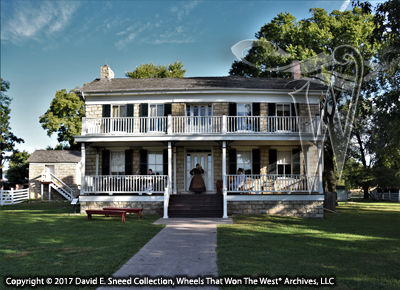Last week, I shared a few of the activities and behind-the-scenes events from the recent Santa Fe Trail Association Symposium held in Olathe, Kansas. This week, I'm continuing coverage of the gathering with a focus on the happenings at the historic Mahaffie Stagecoach Stop and Farm. On October 18th, I'll finish up the highlights with a look at our trip to the Steamboat Arabia Museum and the Fort Leavenworth Frontier Museum. Each of these settings provided an amazing backdrop for studying America's early trail and transportation history.
 |
| On the National Register of Historic Places, the Mahaffie home served passengers traveling with the 'Barlow,Sanderson and Company' stagecoach line during the nineteenth century. |
 |
| While commonplace on the Santa Fe and other trails, the process of yoking and driving oxen is a rare sight today. |
 |
| Don Werner of Werner Wagon Works demonstrated the art and science involved in hot-setting wagon tires. |
The Mahaffie Stagecoach Stop and Historic Farm is located just across the street from where the formal presentations took place in the Olathe Community Center. Friday, September 29th, a host of activities were on tap for the symposium attendees. Don Werner of Werner's Wagon Works shared a wealth of information related to the design and construction of wagon wheels. Tim Talbott, Mahaffie Site Director,discussed the process of yoking oxen and Rawhide Johnson gave a particularly interesting firsthand account of stage coaching. Turns out that his dad had purchased a stagecoach line (complete with coaches) in the early part of the twentieth century. What an amazing opportunity! Doug Hansen followed up with more details on various accoutrements of staging and wagon driving while Greg VanCoevern shared aspects of his army ambulance and Jeff McManus and Cameron Bean conducted blacksmithing seminars. It was a full day of demonstrations which also included tours of the historic Mahaffie farm and period home. The Mahaffie farm was a stage stop for passing travelers as early as the Civil War. Today, the home stands as one of the few, surviving stage coach stops on the Santa Fe Trail. The preservation of the facilities allows visitors from all over the world to learn more about U.S. frontier travel as well as life on an 1860's-era farm.
 |
| Traditional blacksmithing techniques andt ools were highlighted by Jeff McManus and Cameron Bean from the National Stagecoach and Freight Wagon Association. |
 |
| Part of Doug Hansen's on-site presentations included highlights on braking methods used on early western vehicles. |
Next week, I'll wrap up our coverage of the 2017 Santa Fe Trail Association Symposium with a look at our visit to the Steamboat Arabia Museum and Fort Leavenworth Frontier Museum. Both locales provided a great deal of insight into early freighting, travel on American trails, and the vehicles used throughout the frontier.
Please Note: As with each of our blog writings, all imagery and text is copyrighted with All Rights Reserved. The material may not be broadcast, published, rewritten, or redistributed without prior written permission from David E. Sneed, Wheels That Won The West® Archives, LLC




